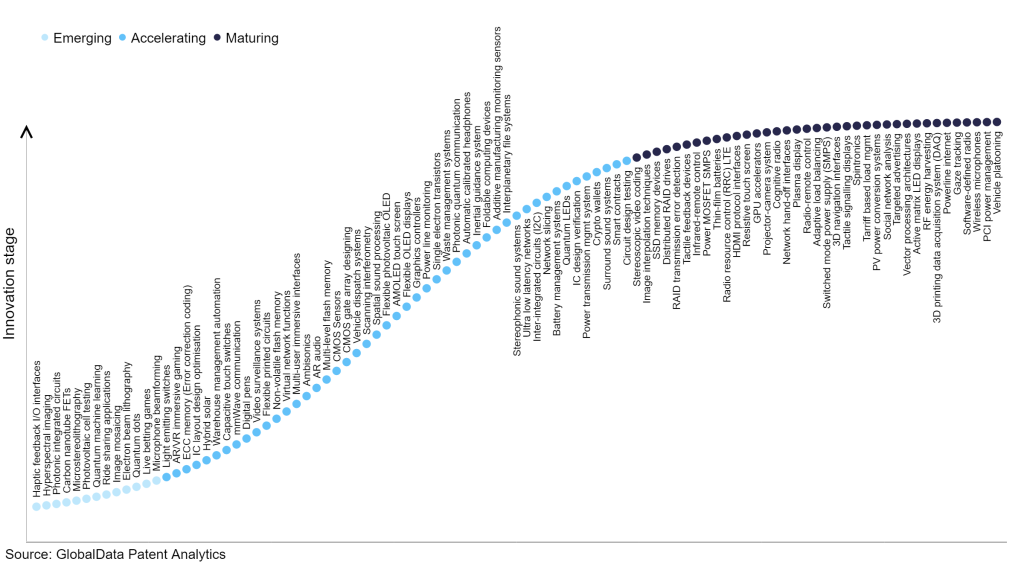The technology industry continues to be a hotbed of innovation, with activity driven by the advancements in imaging technology. The growing significance of complementary metal oxide semiconductor (CMOS) can also be attributed to lower power consumption, higher integration capabilities, cost-effectiveness, and improved performance, this is driving the increased adoption of CMOS sensors in various industries, from consumer electronics to automotive and IoT devices. The growing importance of image sensor array, backside illumination (BSI) technology, image signal processing and time-of-flight (ToF) technologies is further driving innovation in the technology industry. CMOS sensors may also incorporate on-chip noise reduction and high dynamic range technology to minimize unwanted noise and capture a wider range of light intensities resulting in improved image quality. In the last three years alone, there have been over 3.6 million patents filed and granted in the technology industry, according to GlobalData’s report on Technology Innovation: CMOS Sensors. Buy the report here.
However, not all innovations are equal and nor do they follow a constant upward trend. Instead, their evolution takes the form of an S-shaped curve that reflects their typical lifecycle from early emergence to accelerating adoption, before finally stabilising and reaching maturity.
Identifying where a particular innovation is on this journey, especially those that are in the emerging and accelerating stages, is essential for understanding their current level of adoption and the likely future trajectory and impact they will have.
300+ innovations will shape the technology industry
According to GlobalData’s Technology Foresights, which plots the S-curve for the technology industry using innovation intensity models built on over 2.5 million patents, there are 300+ innovation areas that will shape the future of the industry.
Within the emerging innovation stage, microphone beamforming, live betting games, and quantum dots are disruptive technologies that are in the early stages of application and should be tracked closely. Circuit design testing, smart contracts, and surround sound systems are some of the accelerating innovation areas, where adoption has been steadily increasing. Among maturing innovation areas are vehicle platooning and PCI power management, which are now well established in the industry.
Innovation S-curve for the technology industry

CMOS sensors is a key innovation area in technology
CMOS sensors, employed in cameras, are digital image sensors responsible for capturing and converting light into electronic signals. These sensors, widely utilized in various devices, including cameras, consist of a multitude of small photodiodes made of metal-oxide semiconductor materials, functioning collectively to capture incoming light.
GlobalData’s analysis also uncovers the companies at the forefront of each innovation area and assesses the potential reach and impact of their patenting activity across different applications and geographies. According to GlobalData, there are 40+ companies, spanning technology vendors, established technology companies, and up-and-coming start-ups engaged in the development and application of CMOS sensors.
Key players in CMOS sensors – a disruptive innovation in the technology industry
‘Application diversity’ measures the number of different applications identified for each relevant patent and broadly splits companies into either ‘niche’ or ‘diversified’ innovators.
‘Geographic reach’ refers to the number of different countries each relevant patent is registered in and reflects the breadth of geographic application intended, ranging from ‘global’ to ‘local’.
Patent volumes related to CMOS sensors
Source: GlobalData Patent Analytics
Sony Group is a leading patent filer, in the CMOS sensors space.. One of the company’s patents describes a solid-state imaging device and electronic device featuring symmetrical transistor groups. The solid-state imaging device includes multiple pixel sharing units, each containing multiple photoelectric conversion sections corresponding to pixels, an accumulation section shared by the photoelectric conversion sections to accumulate charges, and multiple transistors for controlling charge reading. The transistors within each pixel sharing unit are arranged symmetrically, including a switch transistor for adjusting conversion efficiency. These inventions can be applied to back-illuminated CMOS image sensors, among other applications. Other prominent patent filers in the space include Canon and Samsung.
In terms of geographic reach, GuangDong OPPO Mobile Telecommunications leads the pack, followed by T Chronocam and Quantum-Si. In terms of application diversity, Quantum-Si holds the top position, followed by Semiconductor Energy Laboratory and Taiwan Semiconductor Manufacturing.
CMOS sensors play a crucial role in modern imaging technology, offering numerous advantages. They provide high image quality, low power consumption, and compact size, making them ideal for portable devices such as smartphones and digital cameras. CMOS sensors also enable faster image capture and offer versatility in terms of integration with other electronic components, driving innovation in various industries from consumer electronics to automotive and healthcare.
To further understand the key themes and technologies disrupting the technology industry, access GlobalData’s latest thematic research report on Technology.
Data Insights
From

The gold standard of business intelligence.
Blending expert knowledge with cutting-edge technology, GlobalData’s unrivalled proprietary data will enable you to decode what’s happening in your market. You can make better informed decisions and gain a future-proof advantage over your competitors.







